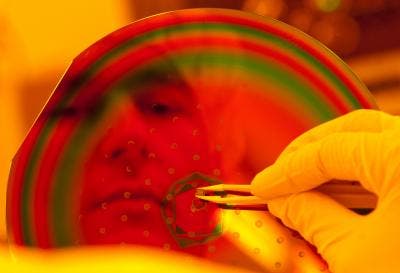
Rice graduate student Ivan Knez holding a semiconductor chip, which contains hundreds of tiny "electron superhighways, " submicroscopic devices that could one day be useful for building quantum computers. (c) Jeff Fitlow/Rice University
Physicists from Rice University have made an important break through in the field of quantum computing, after creating a tiny “electron superhighway”, critical for the development of the first working quantum computer. The quantum computer is thought to revolutionize the computing scene of the future, and is believed by many to hold the same impact that microprocessors first had in 1970.
When finally operational, a quantum computer would be able to store information in both 0 and 1 states, at the same time. Today’s conventional, highly limited binary machines can only process 1 and 0 states one at a time. This is made possible by harnessing the perks of quantum mechanics, and devising quantum bits, or “qubits”, which can store both states at the same time. By concomitantly processing both states, significant computing difficulties we’re experiencing today might become trivial. Thus, complicated processing tasks like climate modeling, bio research, code breaking and such will become highly easy to solve.
“In principle, we don’t need many qubits to create a powerful computer,” explained Du. “In terms of information density, a silicon microprocessor with 1 billion transistors would be roughly equal to a quantum processor with 30 qubits.”
In a recent paper in Physical Review Letters, Rice physicists Rui-Rui Du and Ivan Knez describe a new method for making a tiny device called a “quantum spin Hall topological insulator.” Maybe the greatest issue researchers face in their strive to make quantum computing technology a reality is that of making reliable qubits. Information gets lost over time due to quantum fluctuations, a phenomenon known as “fault tolerance”.
Rice researchers had a different approach to creating qubits, called “topological quantum computing”. Topological designs are expected to be more fault-tolerant than other types of quantum computers because each qubit in a topological quantum computer will be made from a pair of quantum particles that have a virtually immutable shared identity. This pair of quantum particles, called “Majorana fermions”, however have yet to be observed experimentally, although they’ve discussed since 1937.
Topological insulators are very interesting. Oddly enough, electricity doesn’t flow through these conductors, insteady it flows around their narrow edges. If a small square of a topological insulator is attached to a superconductor, Knez said, the elusive Majorana fermions are expected to appear precisely where the materials meet. If this proves true, the devices could potentially be used to generate qubits for quantum computing, he said.
“We are well positioned for the next step. Meanwhile, only experiments can tell whether we can find Majorana fermions and whether they are good candidates for creating stable qubits,” Du said.
Building the first working quantum computer is a race which just got closer to its finish line.









